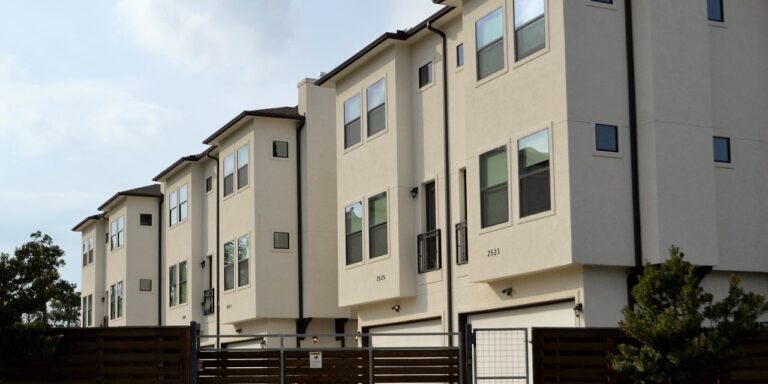The Step-By-Step Guide to Rental Real Estate Investing
The Ultimate Rental Real Estate Investing Strategy is a unique Strategy that helps real estate investors acquire more rental properties without having to spend a lot of time looking for properties, negotiating the best deals, or finding tenants to complete more deals. The following is a step-by-step guide to rental real estate investing and are the recommended steps you should follow:
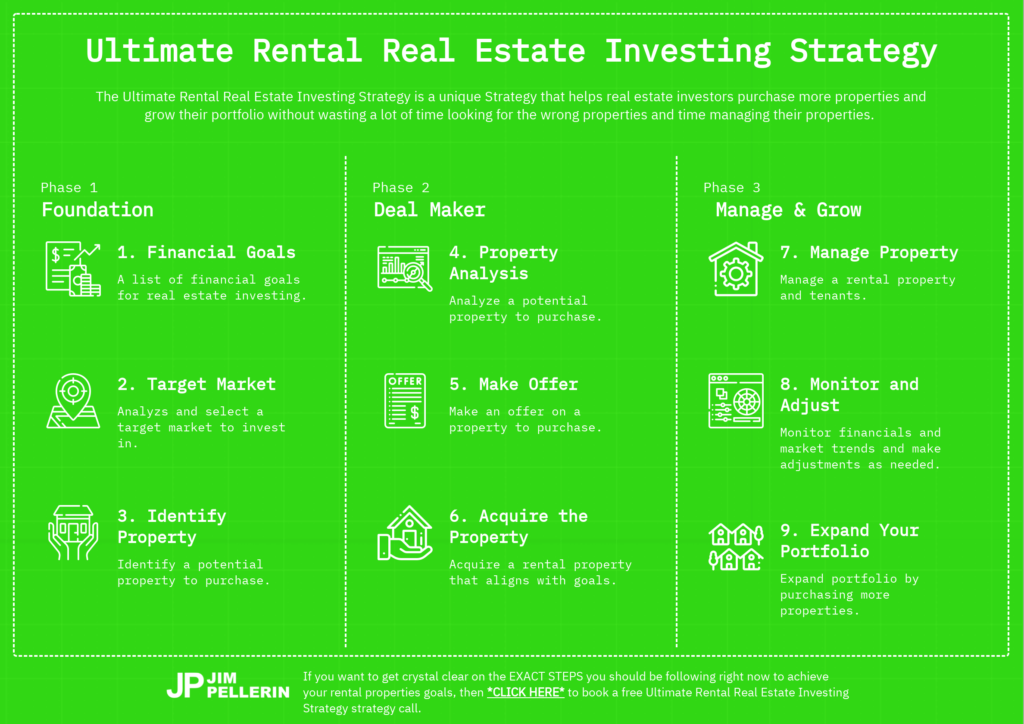
Foundation
- Determine Your Financial Goals: Identify your financial goals and investment objectives, and decide how much you can afford to invest. Calculate your expected returns and cash flow.
- Select a Target Market: Analyze the local real estate market, evaluate the supply and demand for rental properties, look at the rental rates in the area, consider the potential for appreciation and select a market.
- Find a Property: Identify potential properties that fit your criteria. Assess the property’s condition and potential for rental income. Consider financing options and calculate the costs.
Deal Maker
- Analyze the Property: Analyze the property’s cash flow and return on investment. Look at expenses such as property taxes, maintenance, and insurance. Determine the property’s potential for appreciation.
- Make an Offer: Make an offer on the property. Negotiate the terms of the purchase agreement.
- Acquire Property: Secure financing for the rental property. Consider options such as a conventional mortgage, FHA loan, or hard money loan. Close the deal.
Manage and Grow
- Manage the Property: Find tenants and manage the rental property. Set rental rates, screen tenants, and handle maintenance and repairs.
- Monitor and Adjust: Monitor the property’s performance. Adjust rental rates and expenses as needed. Look for opportunities to improve the property’s value and cash flow.
- Expand Your Portfolio: Once you’ve successfully invested in one rental property, consider expanding your portfolio and investing in additional properties to increase your cash flow and portfolio value.
Foundation
Step 1: Determine Your Financial Goals
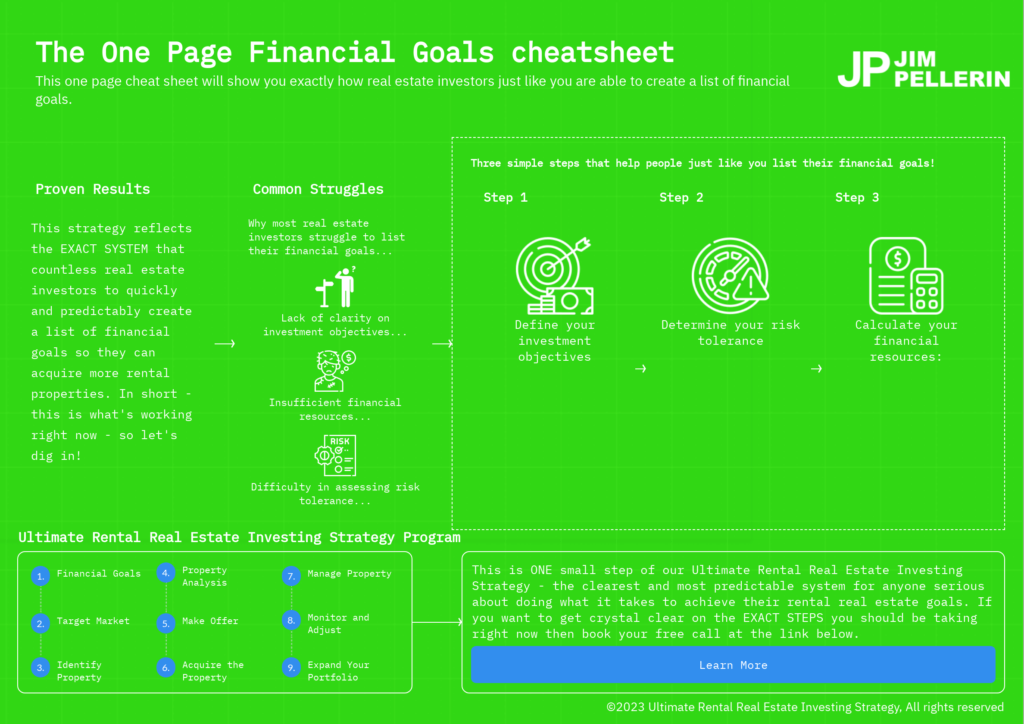
Identifying your financial goals and investment objectives is the first step in rental real estate investing. This includes deciding how much money you can afford to invest and calculating your expected returns and cash flow.
Your financial goals may vary depending on factors such as your risk tolerance, investment timeline, and overall financial situation. For example, if you’re looking for a steady stream of passive income, you may focus on finding properties with high rental yields. On the other hand, if you’re looking for long-term appreciation, you may prioritize properties with good potential for appreciation.
Steps
- Define your investment objectives: Consider what you want to achieve through rental real estate investing. Are you looking for long-term capital growth, passive income, or a combination of both?
- Determine your risk tolerance: Assess how much risk you are willing to take on. This will influence your investment decisions, such as the type of property you invest in and the financing options you choose.
- Calculate your financial resources: Evaluate your current financial situation, including your income, savings, and debt. Determine how much you can afford to invest in rental real estate and how much you need to borrow.
Challenges
- Lack of clarity on investment objectives: Without clear investment objectives, it can be difficult to make informed decisions about which properties to invest in and how to structure financing.
- Insufficient financial resources: Rental real estate investing can require a significant amount of capital. If you don’t have enough money saved, it can be challenging to get started.
- Difficulty in assessing risk tolerance: It can be challenging to accurately assess your risk tolerance, especially if you’re new to investing. This can lead to making overly risky or overly cautious investment decisions.
Step 2: Select a Market
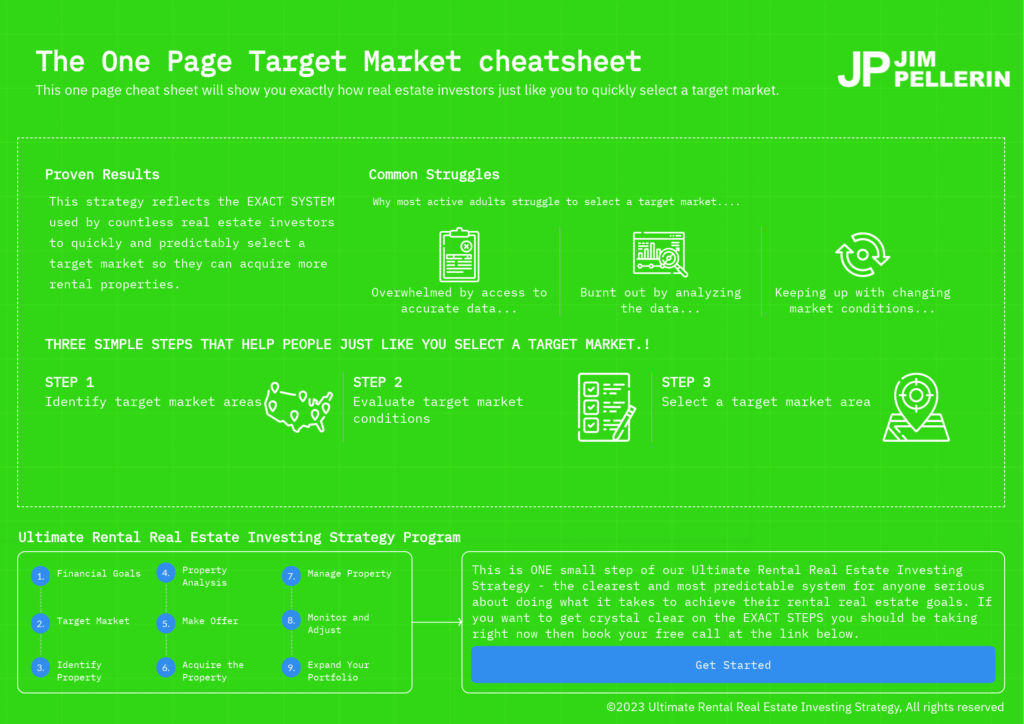
To make informed decisions about rental real estate investing, it’s essential to analyze the real estate markets. This involves Identifying target market areas, evaluating current target market conditions for rental history, and looking at current market trends.
You should also analyze the real estate investing oppoirtunity. This involves evaluating the supply and demand for rental properties, looking at the rental rates in the area, and considering the potential for appreciation.
You can use online tools and resources to access real estate data and market trends. By researching the market, you can identify potential opportunities and avoid investing in areas that may not be profitable.
Steps
- Identify target market areas: The first step in researching the market is to identify the areas where you want to invest in rental properties. This involves looking at factors such as population growth, job opportunities, and demographic trends. You can use online tools like census data and real estate websites to help you identify potential target areas.
- Evaluate current target market conditions: Once you have identified your target market areas, you need to evaluate the rental history of the area. This includes looking at vacancy rates, rental prices, and the overall demand for rental properties in the area. You also need to look at the current market trends. This includes looking at factors such as interest rates, employment rates, and the overall health of the local economy..
- Select a target market: Once you have analyzed all the data, you willchoose your target market area that is ideal for your investment goals and has the best market conditions for your rental property acquisition.
Challenges
- Gathering accurate data: One of the biggest challenges in researching the market is gathering accurate and reliable data. Real estate data can be complex and can vary by location, which can make it challenging to compare and analyze data from different areas.
- Analyzing data: Even if you have access to accurate data, analyzing it can be challenging. Real estate data can be complex and can involve a lot of variables, which can make it difficult to draw meaningful conclusions.
- Keeping up with changing market conditions: Real estate markets are constantly changing, and it can be challenging to keep up with the latest trends and market conditions. To be successful in rental real estate investing, it’s important to stay up-to-date on market trends and conditions in your target areas.
Step 3: Identify Properties
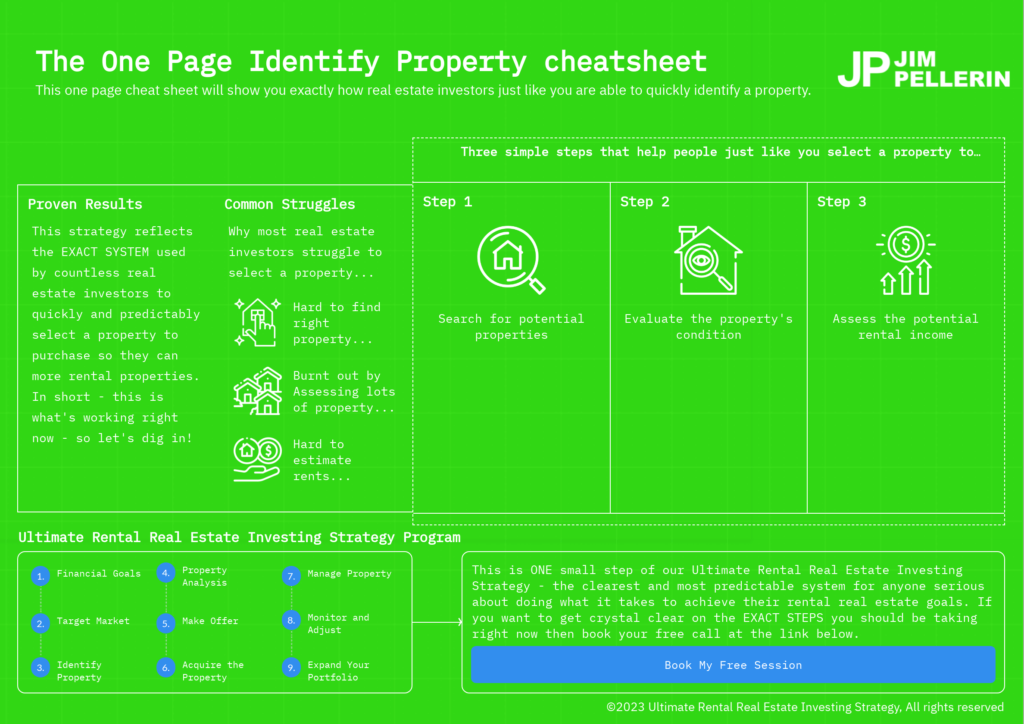
After choosing a location, the next step is to identify potential properties that fit your criteria. You should assess the property’s condition and potential for rental income. This includes looking at factors such as the number of bedrooms and bathrooms, the age of the property, and the rental rates of comparable properties in the area. You should also consider financing options and calculate the costs associated with the property.
Steps
- Search for potential properties: You can use online resources, such as real estate listing websites or work with a real estate agent to find potential properties that match your criteria.
- Evaluate the property’s condition: Once you’ve identified a potential property, you should evaluate its condition. Consider factors such as the age of the property, the condition of the roof, HVAC system, plumbing, and electrical systems. You may also want to hire a home inspector to thoroughly evaluate the property and identify any issues that may need to be addressed.
- Assess the potential rental income: After evaluating the property’s condition, you should assess its potential rental income. You can research the rental rates of comparable properties in the area to get an idea of what you can expect to charge for rent. You should also factor in any expenses associated with owning the property, such as property taxes, maintenance, and insurance.
Challenges
- Finding the RIGHT property: It can be challenging to find a property that meets your criteria, especially if you’re looking for a property in a competitive market.
- Assessing the condition of the property: Evaluating the condition of a property can be difficult, especially if you don’t have experience in real estate. Hiring a home inspector can help, but this can also add to the overall costs of the investment.
- Estimating potential rental income: Estimating potential rental income can be tricky, as it may be influenced by various factors such as market conditions, local competition, and the quality of the property. It’s important to do thorough research and analysis to make accurate predictions about rental income.
Deal Maker
Step 4: Analyze the Property
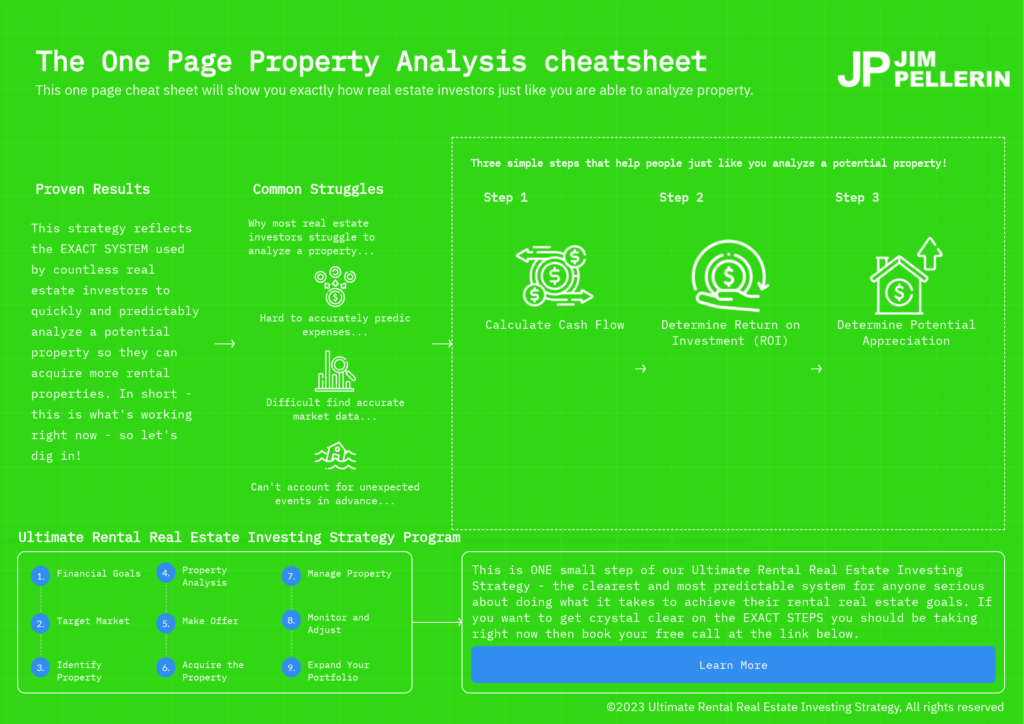
Once you’ve identified a potential property, it’s important to analyze the property’s cash flow and return on investment. You should look at expenses such as property taxes, maintenance, and insurance. You should also determine the property’s potential for appreciation by analyzing market trends and comparing the property to similar properties in the area.
By analyzing the property, you can make informed decisions about whether to invest and how much to invest.
Steps
- Calculate Cash Flow: Analyze the property’s cash flow by subtracting all expenses (including mortgage payments, taxes, insurance, maintenance, and vacancy costs) from the expected rental income. This will give you a good idea of how much cash flow the property can generate.
- Determine Return on Investment (ROI): Calculate the property’s ROI by dividing the net income by the total investment (including the down payment and any additional expenses). This will help you determine how much return you can expect on your investment.
- Determine Potential Appreciation: Analyze market trends and compare the property to similar properties in the area to determine the potential for appreciation. This will help you make informed decisions about the property’s long-term profitability.
Challenges
- Accurately Predicting Expenses: It can be difficult to accurately predict expenses associated with a rental property, such as maintenance and vacancy costs. This can impact the property’s cash flow and ROI.
- Difficulty in Finding Accurate Market Data: It can be challenging to find accurate market data, such as rental rates and property values. This can make it difficult to accurately analyze a property’s potential profitability.
- Accounting for Unexpected Events: Unexpected events such as natural disasters or changes in local ordinances can impact a rental property’s profitability. It’s important to consider potential risks and have contingency plans in place.
Step 5: Make an Offer

After analyzing the property, the next step is to make an offer on the property. You should negotiate the offer price and the terms of the purchase agreement and ensure that the agreement includes all necessary contingencies to protect your investment.
Steps
- Determine a fair offer price: Before making an offer, you should determine a fair price for the property based on your analysis of the property’s cash flow, market value, and potential for appreciation. Consider factors such as the property’s condition, location, and rental income potential.
- Consult with a real estate agent or attorney: It’s recommended to seek the advice of a real estate agent or attorney to help you draft an offer and ensure that it includes all necessary contingencies and protections. They can also provide guidance on negotiating with the seller and counter offers.
- Submit the offer: Once you’ve determined a fair offer price and consulted with a professional, you can submit the offer to the seller. It’s important to be prepared to negotiate and potentially revise your offer based on the seller’s response.
Challenges
- Competition from other buyers: Depending on the market, there may be competition from other buyers, which can make it difficult to secure a property at a fair price.
- Negotiating with the seller: Negotiating with the seller can be challenging, especially if they have a strong emotional attachment to the property or are not motivated to sell at a fair price.
- Meeting the seller’s requirements: The seller may have specific requirements for the purchase agreement, such as a quick closing timeline or certain contingencies that need to be met, which can make it difficult to negotiate a fair deal.
Step 6: Acquire Property
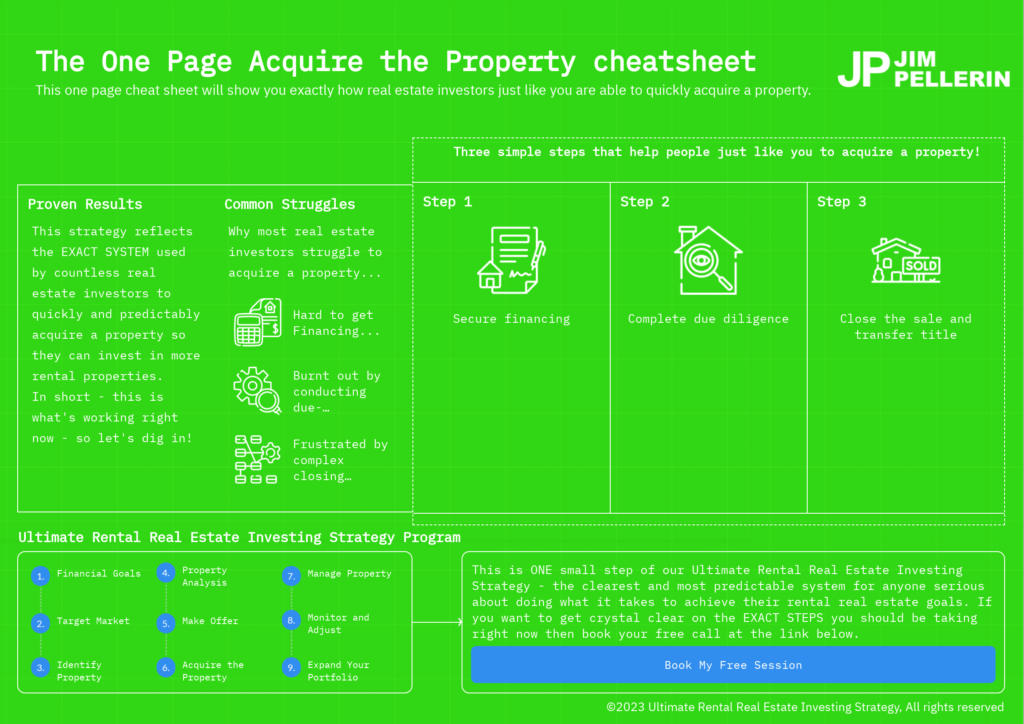
Once you’ve made an offer and the purchase and sale agreement is accepted, the next step is to secure financing and acquire the property. For financing, you should consider options such as a conventional mortgage, FHA loan, or hard money loan. You should also ensure that you have a solid understanding of the terms and conditions of the loan.
Once the financing is obtained and a property inspection is completed, the final strep is to close the deal which includes the transfer of funds and the transfer of title.
Steps
- Secure financing: After the purchase and sale agreement is accepted, you need to secure financing for the property. You can either pay for the property in cash or obtain a mortgage from a lender. To obtain a mortgage, you will need to provide financial information and undergo a credit check. You may also need to provide a down payment for the property.
- Complete due diligence: Before closing on the property, it’s important to complete your due diligence. This may include a property inspection, title search, and review of any existing leases or rental agreements. This will help ensure that there are no hidden issues or liabilities with the property.
- Close the sale: Once you have secured financing and completed your due diligence, you can proceed with closing the sale. This involves signing the necessary documents and paying any remaining fees or expenses associated with the purchase.
Challenges
- Difficulty obtaining Financing: Obtaining financing can be a challenge, especially if you have a limited credit history or low income. You may need to shop around for lenders or consider alternative financing options such as private loans.
- Time for due diligence: Completing due diligence can be time-consuming and expensive. It’s important to be thorough, but this can also delay the acquisition process.
- Complex Closing Process: Closing on a property can be a complex process involving multiple parties and legal documents. It’s important to have a good understanding of the process and work with experienced professionals to ensure a smooth closing.
Manage and Grow
Step 7: Manage the Property
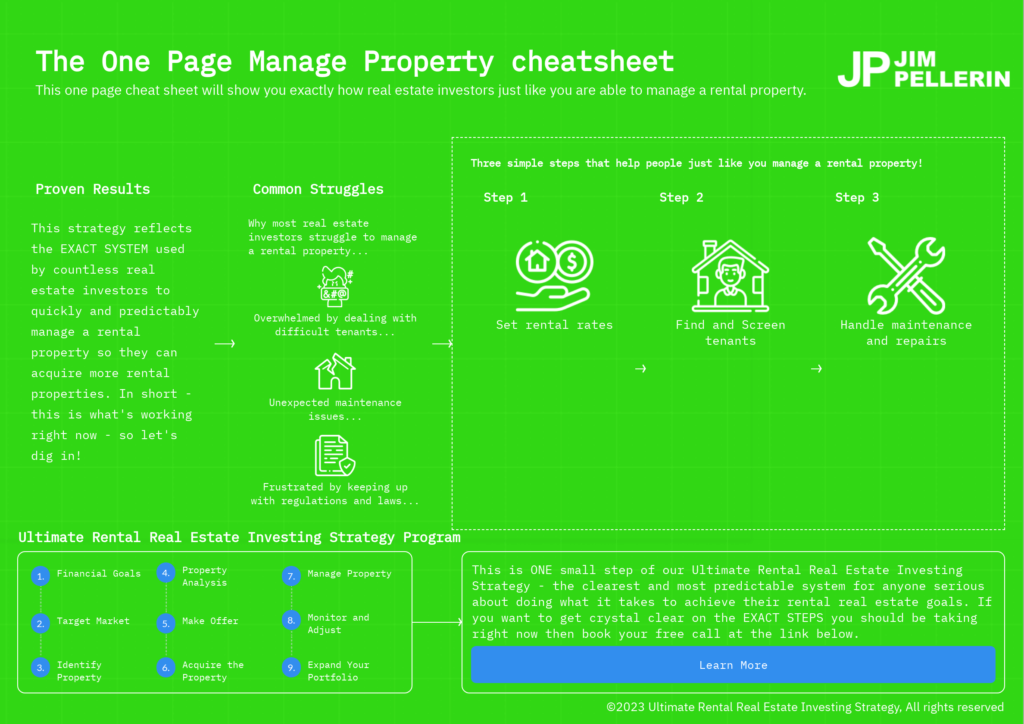
After securing financing, the next step is to find tenants and manage the rental property. This includes setting rental rates, screening tenants, and handling maintenance and repairs. You should also ensure that you have a solid understanding of landlord-tenant laws and regulations in your area.
Steps
- Setting rental rates: It’s essential to set a competitive rental rate that provides you with a decent return on investment while also attracting good tenants. You can research rental rates in the area to help you determine the best rate.
- Finding and Screening tenants: It’s crucial to screen potential tenants carefully to ensure that they can pay rent on time and take care of the property. You can conduct background and credit checks and verify employment and income to ensure that you select the best tenants.
- Handling maintenance and repairs: As a landlord, you’re responsible for maintaining the property and handling any repairs that arise. It’s important to respond promptly to maintenance requests and ensure that the property is safe and habitable for tenants.
Challenges
- Dealing with difficult tenants: Tenants who cause problems can be a challenge for landlords. You may need to navigate legal procedures to evict non-paying or problem tenants.
- Handling unexpected maintenance issues: Maintenance and repair issues can arise unexpectedly and may require immediate attention. This can be costly and time-consuming for landlords.
- Keeping up with regulations and laws: Landlord-tenant laws and regulations can be complex and vary by location. It’s important to stay up-to-date on these regulations and ensure that you’re in compliance to avoid legal issues.
Step 8: Monitor and Adjust
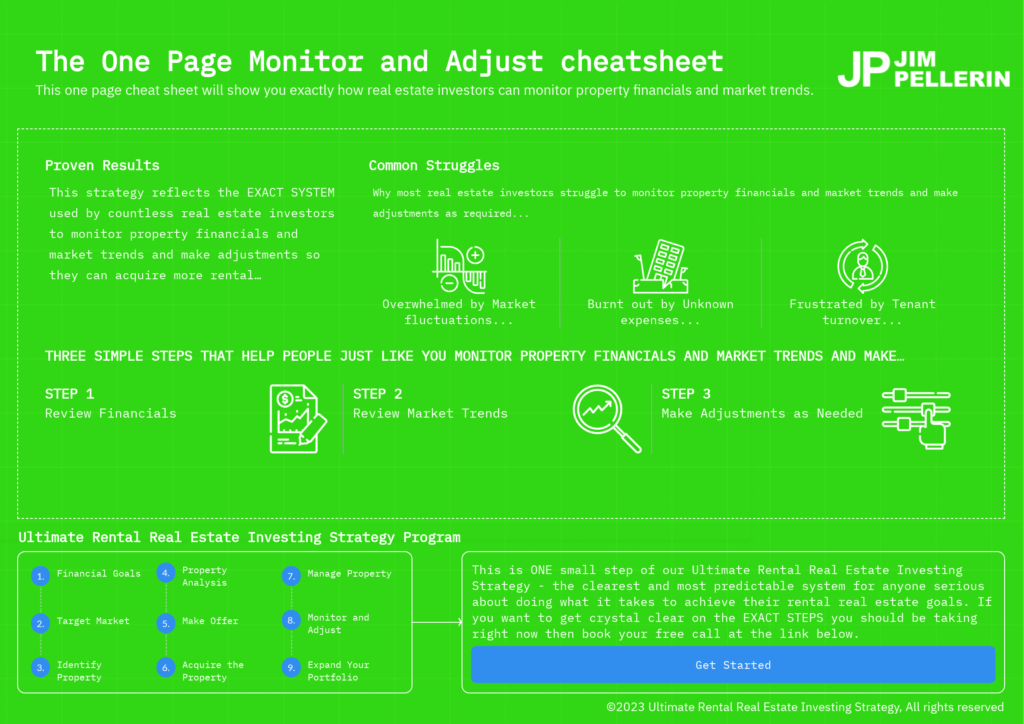
As a rental property owner, it’s important to monitor the property’s performance regularly. You should adjust rental rates and expenses as needed to maximize your cash flow and profitability. You should also look for opportunities to improve the property’s value and cash flow by making improvements or upgrades.
Steps
- Review Financials: Regularly review your rental income and expenses to ensure that the property is performing as expected. By monitoring regularly, you can identify any trends or issues that may be impacting your cash flow and profitability.
- Review Market Trends: Keep an eye on market trends and changes that may impact rental demand or property value in your area. This includes staying up to date with local economic conditions, population growth, and changes in the rental market.
- Make Adjustments: Make adjustments to your rental rates, expenses, or property management strategy as needed to optimize cash flow and profitability. This may involve reducing expenses, such as finding more affordable maintenance services or reducing property management fees. Alternatively, you may need to increase your rental rates to keep up with inflation or to account for improvements you have made to the property.
Challenges
- Market fluctuations: Real estate markets can be unpredictable, and external factors such as economic conditions, job growth, and population changes can impact rental demand and property values.
- Maintenance and repair costs: Unexpected repairs or maintenance can impact your cash flow and profitability, and it’s important to have a plan in place to handle these expenses.
- Tenant turnover: Vacancies can impact your cash flow, and finding new tenants can be time-consuming and costly. It’s important to have a solid tenant screening process in place and to maintain positive relationships with your tenants to reduce turnover.
Step 9: Expand Your Portfolio

Once you’ve successfully invested in one rental property, consider expanding your portfolio and invest in additional properties to increase your cash flow and portfolio value. You should continue to repeat the steps outlined above to ensure that you make informed investment decisions and minimize risks.
Expanding your rental real estate portfolio can provide you with greater cash flow and long-term financial security.
Steps
- Re-evaluate your financial goals and investment objectives: Before expanding your portfolio, re-evaluate your financial goals and investment objectives. Consider factors such as your risk tolerance, investment timeline, and overall financial situation to ensure that investing in additional properties aligns with your overall financial plan.
- Research potential markets and properties: Conduct thorough market research to identify potential markets and properties that align with your investment objectives. Look for markets that have a strong demand for rental properties, affordable but have good potential for appreciation, and offer solid returns on investment. Evaluate potential properties based on factors such as the property’s location, condition, potential for rental income and appreciation, and financing options.
- Secure financing and purchase properties: Once you’ve identified a potential property, secure financing that aligns with your investment objectives. Consider options such as a conventional mortgage, FHA loan, or hard money loan, and ensure that you have a solid understanding of the terms and conditions of the loan. Purchase additional properties.
Challenges
- Increased financial risk: Expanding your portfolio can increase your financial risk, particularly if you’re investing in multiple properties at once. Ensure that you have a solid understanding of the financial risks involved in each property you invest in and have contingency plans in place to mitigate these risks.
- Time and management constraints: Managing multiple rental properties can be time-consuming and challenging. Consider hiring a property manager to help manage your properties, or explore other options such as real estate investment trusts (REITs) that can provide exposure to rental real estate without requiring active management.
- Market volatility: The real estate market can be volatile, and investing in additional properties can expose you to greater market risks. Stay up-to-date with market trends and be prepared to adjust your investment strategy as needed to mitigate risks and maximize returns.
Disclosure: I may receive affiliate compensation for some of the links at no cost to you if you decide to purchase a paid plan. This site is not intending to provide financial advice. This is for entertainment and information only.
Check out the eBook or Paperbook versions














